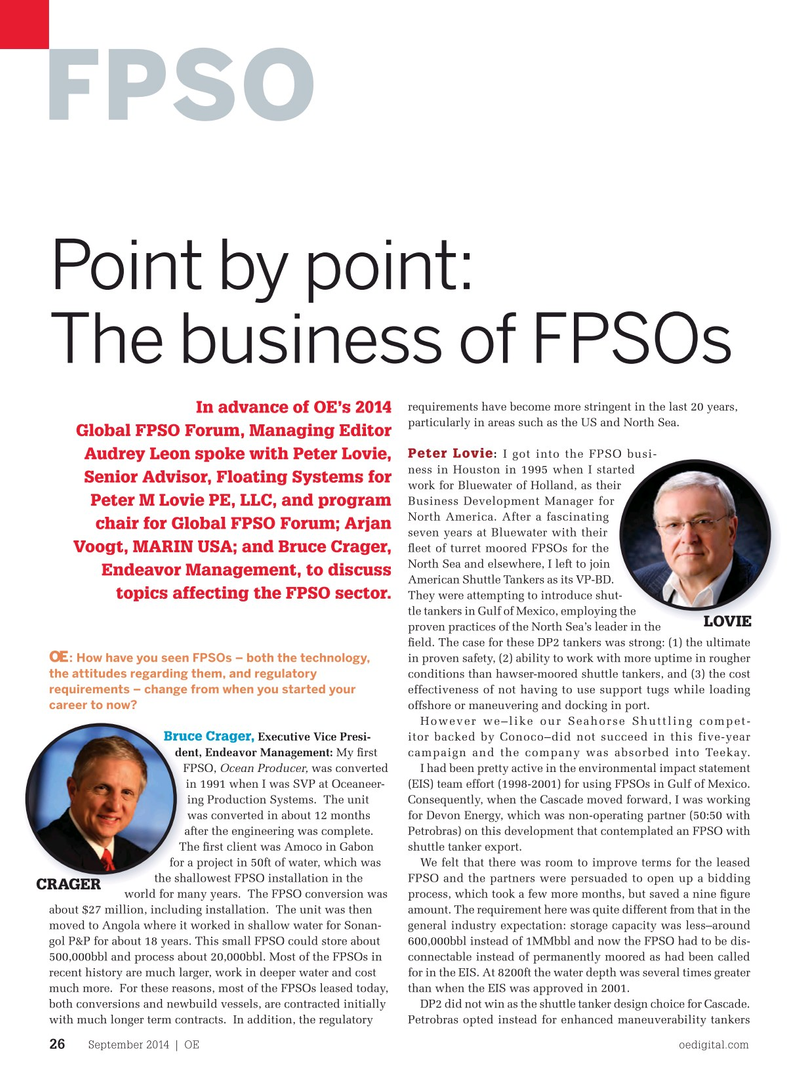
Page 24: of Offshore Engineer Magazine (Sep/Oct 2014)
Read this page in Pdf, Flash or Html5 edition of Sep/Oct 2014 Offshore Engineer Magazine
with bow loading, controllable pitch propeller and bow thrusters, still requiring two tugs for loading offshore, plus tugs in port.
You asked about the regulatory side. I have to say that I
FPSO found the USCG and Minerals Management Service (MMS) very willing to listen to new directions in these early formative stages, whether from a contractor or an operator, and where we really went after fundamental sound and safe methods and took a lead in it. Maybe this is an American thing–we did not “go cap in hand as supplicants for papal blessing”–but rather it was an attempt to take the lead and get it right.
Arjan Voogt, Manager of MARIN’s
Point by point:
Houston of? ce: The FPSO community has always been proactive in solving chal- lenges in design and operation together as an industry. The reality that if one of these systems
The business of FPSOs fails all will suffer, is seen by all competitors who work together towards safe and ef? cient operations. Since the FPSO Research
Forum began 17 years ago, many joint industry projects tackled requirements have become more stringent in the last 20 years, important issues like green water and bow slamming, life cycle
In advance of OE’s 2014 particularly in areas such as the US and North Sea. management, mooring integrity and safe of? oading operations.
Global FPSO Forum, Managing Editor : I got into the FPSO busi-I got into the FPSO busi-Peter Lovie OE : Currently, only one company (Petrobras) operates an
Audrey Leon spoke with Peter Lovie,
FPSO in the Gulf of Mexico in the Cascade/Chinook ? eld, ness in Houston in 1995 when I started ness in Houston in 1995 when I started
Senior Advisor, Floating Systems for and Shell is soon to follow with the at its FPSO Turritella work for Bluewater of Holland, as their work for Bluewater of Holland, as their
Stones development. What’s your view of this market?
Business Development Manager for
Peter M Lovie PE, LLC, and program
Will more companies follow suit as production heads into
North America. After a fascinating chair for Global FPSO Forum; Arjan deeper Gulf waters or will US regulations interfere?
seven years at Bluewater with their ? eet of turret moored FPSOs for the
Voogt, MARIN USA; and Bruce Crager,
North Sea and elsewhere, I left to join
Endeavor Management, to discuss
American Shuttle Tankers as its VP-BD. topics affecting the FPSO sector.
They were attempting to introduce shut-They were attempting to introduce shut- tle tankers in Gulf of Mexico, employing the tle tankers in Gulf of Mexico, employing the
LOVIE proven practices of the North Sea’s leader in the proven practices of the North Sea’s leader in the ? eld. The case for these DP2 tankers was strong: (1) the ultimate
OE : How have you seen FPSOs – both the technology, in proven safety, (2) ability to work with more uptime in rougher the attitudes regarding them, and regulatory conditions than hawser-moored shuttle tankers, and (3) the cost requirements – change from when you started your effectiveness of not having to use support tugs while loading career to now?
offshore or maneuvering and docking in port. However we–like our Seahorse Shuttling compet-
Bruce Crager,Bruce Crager, Executive Vice Presi- itor backed by Conoco–did not succeed in this five-year dent, Endeavor Management: dent, Endeavor Management: My ? rst campaign and the company was absorbed into Teekay.
FPSO, FPSO, Ocean Producer, was converted I had been pretty active in the environmental impact statement in 1991 when I was SVP at Oceaneer- in 1991 when I was SVP at Oceaneer- (EIS) team effort (1998-2001) for using FPSOs in Gulf of Mexico. ing Production Systems. The unit ing Production Systems. The unit Consequently, when the Cascade moved forward, I was working was converted in about 12 months was converted in about 12 months for Devon Energy, which was non-operating partner (50:50 with after the engineering was complete. after the engineering was complete. Petrobras) on this development that contemplated an FPSO with
The ? rst client was Amoco in Gabon The ? rst client was Amoco in Gabon shuttle tanker export.
for a project in 50ft of water, which was for a project in 50ft of water, which was We felt that there was room to improve terms for the leased the shallowest FPSO installation in the the shallowest FPSO installation in the FPSO and the partners were persuaded to open up a bidding
CRAGER world for many years. The FPSO conversion was process, which took a few more months, but saved a nine ? gure about $27 million, including installation. The unit was then amount. The requirement here was quite different from that in the moved to Angola where it worked in shallow water for Sonan- general industry expectation: storage capacity was less–around gol P&P for about 18 years. This small FPSO could store about 600,000bbl instead of 1MMbbl and now the FPSO had to be dis- 500,000bbl and process about 20,000bbl. Most of the FPSOs in connectable instead of permanently moored as had been called recent history are much larger, work in deeper water and cost for in the EIS. At 8200ft the water depth was several times greater much more. For these reasons, most of the FPSOs leased today, than when the EIS was approved in 2001.
both conversions and newbuild vessels, are contracted initially DP2 did not win as the shuttle tanker design choice for Cascade. with much longer term contracts. In addition, the regulatory Petrobras opted instead for enhanced maneuverability tankers
September 2014 | OE oedigital.com 26 026_0914_FPSO1_Roundtable.indd 26 8/21/14 2:26 PM

 23
23

 25
25